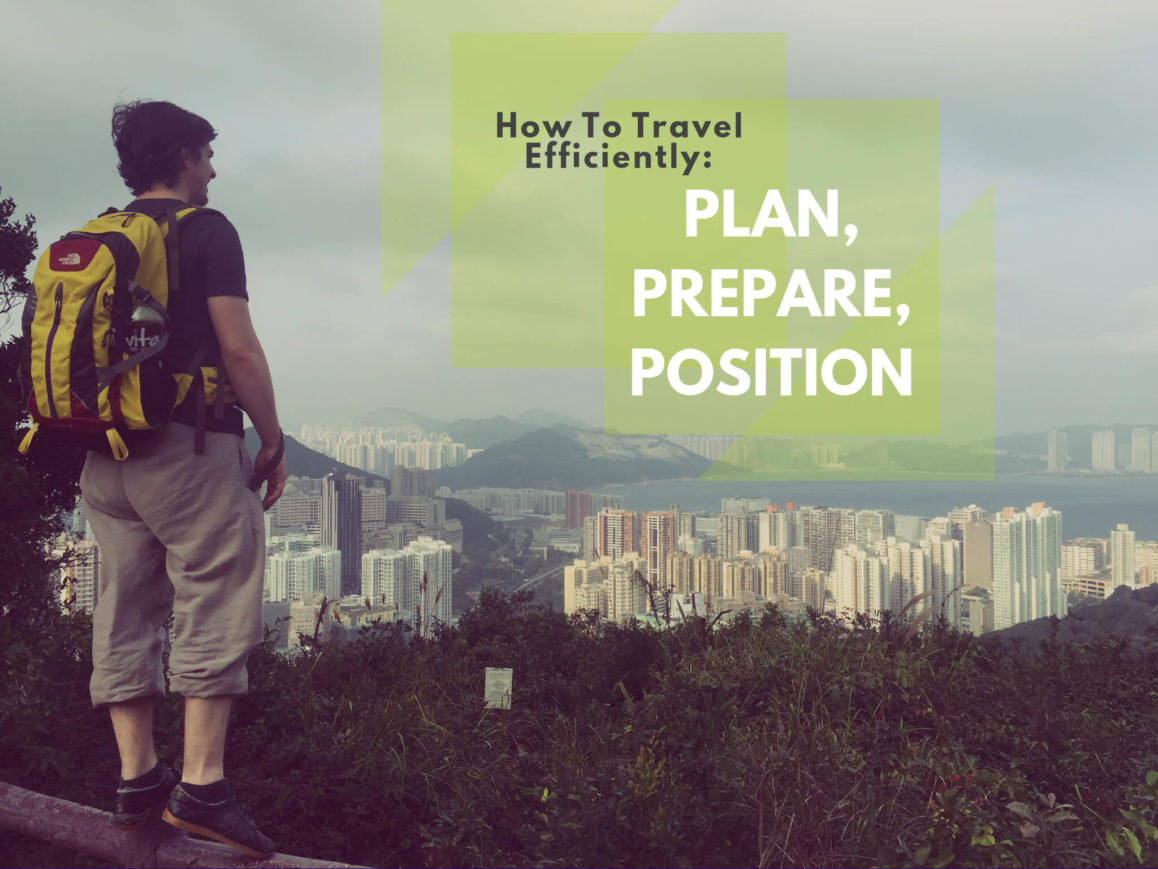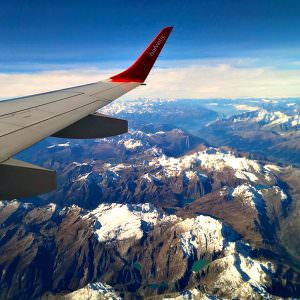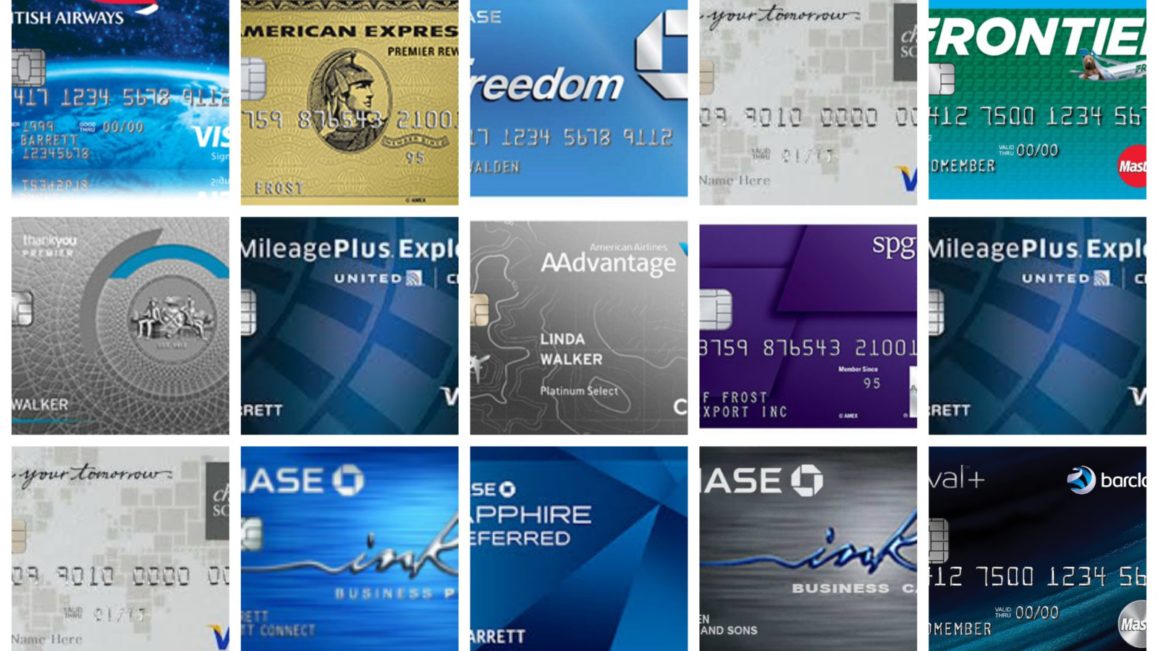How to Travel Efficiently: Plan, Prepare, Position
Short Sad Story
“Bro. Bro!”
“What, man?! What do you want?”
“This isn’t good, bro. I’m really not sure I’m gonna make it through this.”
“Well, man, it’s not like we have any other choice at this point – do we? We’re in the back row of a unairconditioned 12 person van with 16 people inside. We don’t speak Tagalog. And we wouldn’t know how to get back to Puerto Princessa if we tried. Let’s face it – we just got get through it.”
“Ugh. Fine. How are you not dead? You didn’t even sleep. At least I got an hour.”
“I have no idea. Last night was f****** awesome, but had I known our bus ride was going to be six hours of mountainous hell, I probably would have opted to stay in for the night.”
How to Travel Efficiently: Plan, Prepare, Position
[thrive_2step id=’10340′]Download a Free PDF Version of this Article[/thrive_2step]
Part One – Warm-ups
It sounds so simple, but rarely is it done. Plan, Prepare and Position are three fundamental elements for efficient travel – a mantra of NomadsNation. Frankly, the Three P’s could be applied to most aspects of life, but for the sake of time, this article will only discuss them in the context of efficient travel.
The above story (Short Sad Story) is a good example of a bad example of the Three P’s of Travel. There was some planning and positioning (we knew we had to take a bus and where to be for pick up), but there was definitely not any preparing (we did not know sobriety is a MUST for that ride).
Yeah, sure, we made it to El Nido mostly alive. But I’ll be damned if it was a good time getting there. Had we been efficient travelers, we would have found a resource such as IDreamedOfThis before we stepped into the van Charon used to ferry fools to Filipino Paradise (El Nido really is Paradise!).
The bright side of this story (Short Sad Story) is we learned something. Since that trip, I have begun to implement the Three P’s of Travel into all of my adventures.
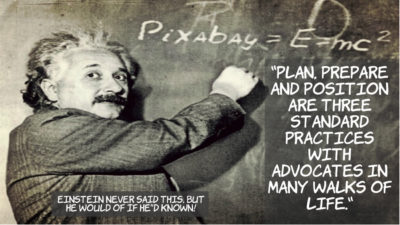

Staying relevant to efficient travel, NomadicMatt (the legend himself) has written incredible articles illustrating the value of both Planning and Preparing, which can be found here and here, respectively. As for Position, it’s a practice I’ve learned through studying business and transferred to the world of travel.
Before we get into the details, let’s have a good example of a good example of the Three P’s of Travel.
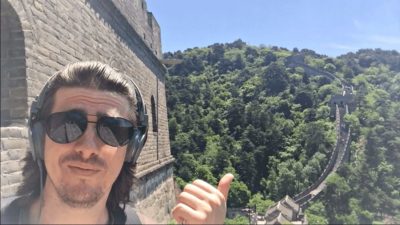

Short Glory Story
“师傅, 你好。我想去长城。 多少钱?”
“ 你会说中文?太好了!朋友,去长城不贵的!你是外国人吗?英国人?美国人?跟我来! 不贵的,五百块。好吧,我们走!”
”多少?五百块?太贵了! 五十块好吗?”
“五十块不行。我儿子病了,需要钱。帮帮忙吧。四百块好不好?”
“四百块太多了。我知道五十块可以去。那儿有很多人去长城。”
“好,好。两百块行不行?你帮我儿子,我带你去长城,在那儿等你,再接你回来。”
“我会在长城三四个小时。如果你等我,我现在给你一半钱,回来给你一半。我给你一百块。”
“好,好。我们一起过去,我在那儿等你,我们再一起回来。走。你现在给我一百,回来再给我一百。“
“不好,不是一百。我现在给你五十,回来给你五十,好吗?”
“好,好。现在七十五,回来七十五,好不好?”
“好。现在七十五,回来七十五。我们走吧。”
Translation
“Hey there. I want to go to the Great Wall. How much will it cost?”
“You speak Chinese? Great! Friend, going to the Great Wall isn’t expensive. Are you a foreigner? English? American? I can take you! It’s not too expensive. 500RMB. Good. Now, let’s leave!”
“HOW MUCH?! 500? Too expensive! How about 50RMB?
“No can do. Right now son is sick. I don’t have much money. Can you help my son? 400RMB?
“I will not give you so much! I know 50RMB is enough. There are plenty of other drivers over there.”
“OK. OK. How about 200RMB? You help my son. I take you there and I bring you back here. I wait for you.”
“I’ll be there for 3 or 4 hours. If you wait, I’ll give you half now and half when we get back. But I’m only give you 100RMB.”
“OK. OK. We go there. I wait. We come back. Now, let’s go. You give me 100 now and 100 when we get back.”
“Not OK! I’ll give 50 now and 50 when we get back. Not 100. OK?”
OK, OK. 75 now and 75 when we get back. OK? Now, we go.”
“Fine. 75 now and 75 later. Let’s go.”
How to Travel Efficiently: Plan, Prepare, Position
Part Two – Starting Line
For this trip, I did my homework. I knew before arriving to the taxi stand there would be a hustle (In fact, I didn’t even take a taxi. It was technically a “private taxi service”, which is basically some dude with a mini-van). I spent some time the night before reading through comments on TripAdvisor to learn about what route I should take to the Great Wall and around about how much it should cost for each part of the trip.
And if you’re thinking, “Did it help he speaks a bit of Chinese?” The answer is, not at all! During the drive there I found out the driver spoke more English than I did Chinese.
More importantly, if you’re wondering whether his mother was actually sick –
Well, I don’t know the answer, but I can tell you that when I was ready to leave I found him sitting at a pub drinking pints of Tsingtao (Chinese Beer)! It was 1130am and he needed a friend to drive me back because he was half-cocked before high noon (Remember – it’s a “Private Taxi Service”).
The moral of the story: I took the time to plan my trip, prepare for the negotiations and position myself in a way that I wouldn’t be screwed if this guy wasn’t willing to lower his price (there were tons of other options at the taxi stand).
How to Travel Efficiently: Plan, Prepare, Position
Part Three – Ready, Set, GO!
The Three P’s of Travel are crucial for all travelers, regardless of previous experience. The best part about them is they can be adjusted for individual travel preferences. Let’s go through them one-by-one to understand exactly what they mean.
Planning is the bedrock of the Three P’s of Travel. It means, do your due diligence and know what you’re getting into.
During my youth, I was never a big planner, but with age (and a few short sad stories) I realized the value of doing just enough planning to make sure I never again ended up in a situation like Short Sad Story.
Over the years I’ve identified 3 core components of planning. These include: Environment, Transit, and Individual Strengths and Weaknesses.
Number ONE – Environment
Environment is a fairly all-encompassing term.
It includes geography, climate, politics, culture, etc…
It is crucial to research these factors at the most basic, but the amount of depth depends on the individual and their traveling aims. Basically, it just means make sure you’re not going to Bangladesh during Monsoon season, Somalia during War season, Patagonia during the Winter season (with Summer clothes) or any other very avoidable bad situation.
Number TWO – Transit
Transit gets it’s own category because is such a major part of travel (and my favorite aspect).
As someone with a terrible sense of direction, I’m guilty of over planning when it comes to transit. I look up things like cheap air-fare, bus routes and fares, taxi fares, travel time, etc… However, I realize some are more gifted than I.
Regardless of your transit skills, having basic knowledge of your travel environment is a good idea. At a bare minimum, at least knowing the address of your intended location is a must. I like to screenshot Google Maps so I never forget.
Number THREE – Individual Strengths and Weaknesses
This is the third component of planning, and it’s probably the most often over-looked. All too often have I let my pride interfere with my travel efficiency.
For example, in the past I always believed I’d be able to find my way back to my hostel or hotel or friend’s place or whatever. But instead, I would make a wrong turn and end up lost, late and a little pissed off.
After years of travel, I’ve recognized my weakness and learned to compensate for it in other ways. As for strengths, they vary from person to person. I consider myself decent enough with language and tech, so I always use these skills in a proactive way.
We all have strengths and weaknesses –
Recognize them. Own them. Use them to your advantage.
In the Three P’s of Travel, Planning is about taking the time to learn your destination and ensure you have enough knowledge to effectively Prepare.
Preparing is the most straight-forward P of the Three P’s of Travel. In a nutshell, it means follow through with your plans so you can position yourself for success.
The long list of things to do during this stage could include:
Booking Transit
Booking Lodging
Preparing for Climate Change
Physical Training
Language Learning
Culture Learning
Dietary Adjustments
ETC…
Depending on your trip length, budget and travel preferences, this list can be highly varied. What matters most is completing your customized list!
Here’s a detailed description of the one I consider most relevant.
Uno – Booking Transit
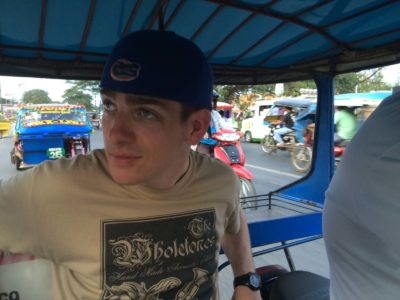

As I’ve mentioned before, transit is one of the largest components of travel. Frankly, it deserves a Back Hack Series of it’s own because there is just so much to consider. However, in the context of this article, it basically includes destination travel (i.e. between towns, cities, regions and countries) and local travel (getting around within your current destination).
For destination travel, I consider Air, Sea and Land the main three modes e.g. plane, boat, bus/train.
By plane


I typically book international airfare no less than 6 weeks ahead and regional airfare no less than 2 weeks ahead (there are obviously exceptions, but this is my rule of thumb).
By boat
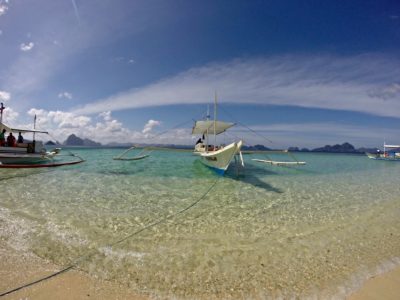

Well, I don’t have much experience as a Seafarer, but with what I have done, 1 week has been more than enough to get me from point A to point B. In my experience, boat ticket prices and time tables are fairly consistent. This is different from airplane prices and time tables, which are much more likely to vary.
By Bus
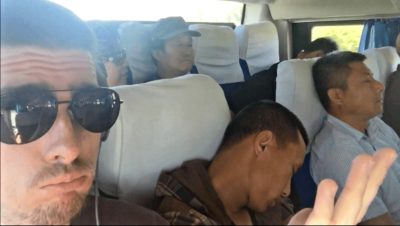

Depending on the distance of travel (i.e. 2hrs or 20hrs), this one can vary. I usually say 1 week ahead for a long trip and 2 days ahead for a short trip. Similar to boat travel, bus prices and time tables are usually pretty consistent.
The tough part for this one (and all transport for that matter) is availability. I’ve definitely been stuck on a 18 hour slow-train ride through rural China in the standing section next to the toilet before, all because I waited too long to buy my tickets.
By Train
This section requires just a bit more caution than bus travel. I’d say 3 days for short-trip and 10 days for a long-trip should suffice. Again, the price and time table are pretty consistent for train travel, so the biggest concern is ticket availability.
For local travel, this is entirely dependent on the location. No matter where you are, there should always be some form of local transit (buses or metro). At first, local transit may be intimidating, but after a few tries it get’s pretty easy. And of course, there are ways to prepare which make this easier (screenshotting maps, local mobile apps, etc).
An alternative to local transit is private transportation. If I have the chance to rent a scooter or motor bike, there is no way I’m missing out! Especially if where I’m lodging is out of the way.
Taxi’s and private drivers (Tuk-Tuks, Rickshaws, etc) are a third option, but make sure to properly plan! That means try to know the approximate cost and travel time of a transit so you don’t get ripped off.
Dos – Booking Lodging
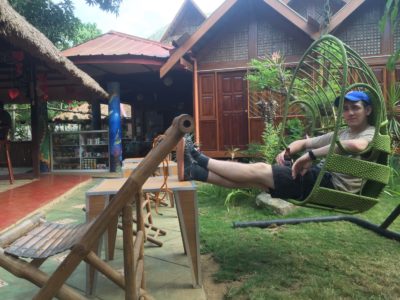

I’m a simple man when it comes to where I sleep. A roof and a blanket will do me just fine in most places. Because of this, I typically only book lodging for the first night and then make my way from there.
However, for those with preferences differing from mine, the amount of time to book ahead depends on destination and budget. Regardless, lodging (for at least the first night) should probably be booked about 1 week ahead of schedule.
Also, because of the communal environment, I’m a strong advocate for staying in hostels instead of hotels or AirBnB. I’ve always found it exciting to meet other travelers with who I can exchange travel tales over a pint!
Tres – Preparing for Climate Change
As for ways to prepare for a change in Climate (as in someone from a cold place traveling to a warm place or vice versa), there’s no real way I know of to physically prepare. I mean, let’s be real – if I’m going to visit Russia, it’s not like I can build a giant freezer in my home and spend three hours a day inside for my body to acclimate to cold weather. It’s not realistic.
The important part is to make sure what you pack is appropriate for your intended destination. Travel Independent is a great resource for what and how to pack. They (and I) support packing light to ease the burden, but for those a bit more cautious there is an expansive guide detailing what to include for mostly any climate around the world.
Cuatro – Physical Training
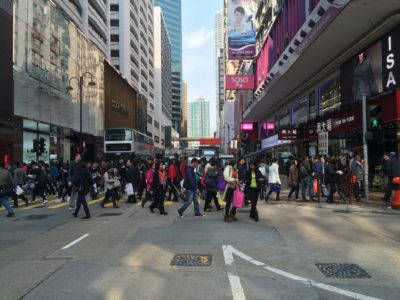

I presently live in Hong Kong which, like most major cities, is a “walking city”. That means a major part of transport is walking all around town. It’s common for me to put in 5km (3.1M) on any given day. In fact, it’s quite easy to put in twice that.
Knowing this, for someone who doesn’t do anything like this on an average day, my advice is to be as physically prepared as possible (within reason, of course). Starting to walk a few laps around the neighborhood a few weeks before you trip is probably a good idea for preparation.
Furthermore, if where you’re going has physical expectations beyond this (like hiking Mt. Kilimanjaro), make sure you take the time to be properly prepared before embarking on your adventure.
Cinco – Language Learning
I’ve spent the last two years of my life learning two dialects of Chinese (Cantonese and Mandarin) and I’m still god awful at speaking. Learning a new language for a brief trip is pretty impractical, of course, but taking the time to learn a few basic phrases usually makes your trip more smooth.
If you’re looking at some extended travel (4+ weeks), learning at least the basic phrases pretty much needs to happen.
Of course learning a new language may be difficult, so I suggest taking advantage of modern tech and let it do the learning for you! I have tons of translation apps on my phone.
**Quick Note: If you’re using apps to translate, check to see if they require Wifi before throwing yourself into an awkward situation.**
Another idea I’m fond of is asking locals to if I can audio/video record them saying a few basic phrases on my telephone. If you walk up to a stranger and ask, it’s going to be super creepy – but, if you’re in a comfortable pub setting where you can buy them a round of drinks, I’m sure they’ll be more than willing assist.
Sies – Culture Learning
As far as culture goes, it’s definitely a must to at least identify some norms. I remember the first time I came to China and witnessed people casually spitting food out of their mouth, back on the the table. I was awe-struck.
This is a pretty tame example, but the point here is to put culture into perspective. The world is a big, beautiful place and a lot cultures have very different ideas of what is and is not acceptable.
Do yourself a favor and make sure you know what you’re getting into before your knee deep.
Siete – Dietary Adjustment
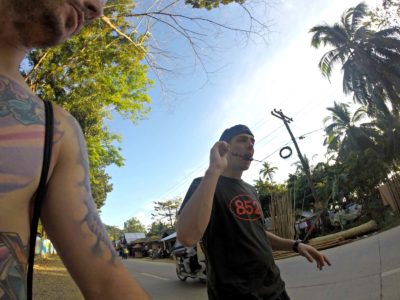

Quite similar to culture, knowing some basics about local diet (and training yourself ahead of time!) is a very good idea.
To keep this as PG as possible – Bubble-butt is real, and it is terrible.
If you can familiarize yourself and your body with whatever dietary environment you’re soon to enter, it is in your best interest to do so as soon as possible!
Ocho – Other
There are countless other things to be considered in the prepare stage of the Three P’s of Travel, but it’s simply impractical to list them all. A few others I would really suggest looking into are:
1) Banking – make sure your bank is aware you’re traveling and you have access to your monies
2) SIM Card – Make sure you notify your mobile service carrier you will be traveling and make any necessary arrangements. Personally, I carry with me during travel and purchase a cheap local SIM card, in case of emergency.
3) Emergency Contact – Notifying an emergency contact where you will be and the duration of your stay is a must! Personally, I advise taking it to the next level and informing your local embassy. For my American brethren, the USA GOV S.T.E.P. Program is a great tool for all travelers.
In the Three P’s of Travel, Preparing is about taking the time to act on your plans, so you are in the best position possible for you travels!
To position yourself well is to ensure fortune remains in your favor. So do yourself a favor and execute your plans the way you intended.
After taking time to plan and prepare, it is wasteful not to position yourself for success. In both stories (Short Sad Story and Short Glory Story), the one constant is position. At a very young age I discovered the unpleasantness of missing out due to my own undoing, and only now do I truly understand the value of proactive positioning.
Proactive positioning is knowing where you need to be because you took the time to plan and prepare.
Of course, we’re limited as to how well we can position ourselves, so the key is to do as best you can within reason.
Looking at Short Sad Story, we knew we needed to take a bus from Puerto Princesa to El Nido, so we found Sheebang Hostel – which set us up with a bus service company able pick us up at the front gate!
Because we positioned ourselves well, there was freedom the night before. It didn’t take much time to set ourselves up, but doing so improved the efficiency of our travel.
In Short Glory Story, I took the time to identify each of the stops on my way to and from the Great Wall of China. I wrote down and learned to say them in English and Chinese, I screenshot maps for the entire route, I had a backup plan for each leg, and most importantly, I downloaded a few podcasts for the 8 hour trip. All together I took a local taxi, a private taxi, three trains, two buses, a ski-lift and a toboggan. Yeah, that’s real talk – I took a toboggan.
Because I planned and prepared (perhaps a bit overzealously), I was easily able to proactively position myself for success throughout the entire journey. Had I not taken the time to do so, I would have surely lost my way at some point along the route (Yay for identifying my individual strengths and weaknesses and being an efficient traveler!).
If Planning is about taking the time to learn your destination, and preparing is about acting on your plans, positioning is about being where you need to be, when you need to be there.
How to Travel Efficiently: Plan, Prepare, Position
Part Four – Finish Line
The root of this article is how to be a modern, efficient traveler. The Three P’s of Travel are simply the means to get there.
An efficient traveler is someone who takes the time to plan an ahead, prepare for the expected or unexpected and position him (or her) self for guaranteed success.
If you have any suggestions/comments/ideas mention your comments below or send me an email at bernie@nomadsnation.com.
Travel on, Nomads.
This is Be-Green,
Signing Out

